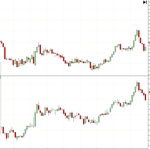I have a couple of questions:
1. Since spread trading is relying on the widening or narrowing of a spread, stop losses on each leg are not practical? Rather one should exit with a loss manually if the spread widens too much when we are betting that it will narrow?
2. What time-frames are usually used? Daily? Minute?
3. How does one find spreads? First you have to find highly correlated markets? Do you chart them both and look for divergence?
4. Do you take profits when they go back to normal? Is it called 'fair value'?
5. What is balancing legs? If I were to spread EURO vs GBP, since EURO is 12.50 and GBP is 6.25, would I use 1 euro to 2 GBP? Or since GBP moves more I would leave it at 1 to 1?
6. I was doing some research and it seems that Agricultures are heavily spread traded but FX is not. Why is this so?
7. In the picture, would I go long the top one and go short the bottom one? Is this how you find spreads, look for divergences?

1. Since spread trading is relying on the widening or narrowing of a spread, stop losses on each leg are not practical? Rather one should exit with a loss manually if the spread widens too much when we are betting that it will narrow?
2. What time-frames are usually used? Daily? Minute?
3. How does one find spreads? First you have to find highly correlated markets? Do you chart them both and look for divergence?
4. Do you take profits when they go back to normal? Is it called 'fair value'?
5. What is balancing legs? If I were to spread EURO vs GBP, since EURO is 12.50 and GBP is 6.25, would I use 1 euro to 2 GBP? Or since GBP moves more I would leave it at 1 to 1?
6. I was doing some research and it seems that Agricultures are heavily spread traded but FX is not. Why is this so?
7. In the picture, would I go long the top one and go short the bottom one? Is this how you find spreads, look for divergences?


